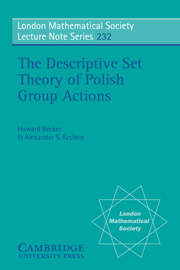Book contents
- Frontmatter
- Contents
- PREFACE
- INTRODUCTION
- 0 DESCRIPTIVE SET THEORY
- 1 POLISH GROUPS
- 2 ACTIONS OF POLISH GROUPS
- 3 EQUIVALENCE RELATIONS
- 4 INVARIANT MEASURES AND PARADOXICAL DECOMPOSITIONS
- 5 BETTER TOPOLOGIES
- 6 MODEL THEORY AND THE VAUGHT CONJECTURE
- 7 ACTIONS WITH BOREL ORBIT EQUIVALENCE RELATIONS
- 8 DEFINABLE CARDINALITY
- References
- Index
5 - BETTER TOPOLOGIES
Published online by Cambridge University Press: 06 July 2010
- Frontmatter
- Contents
- PREFACE
- INTRODUCTION
- 0 DESCRIPTIVE SET THEORY
- 1 POLISH GROUPS
- 2 ACTIONS OF POLISH GROUPS
- 3 EQUIVALENCE RELATIONS
- 4 INVARIANT MEASURES AND PARADOXICAL DECOMPOSITIONS
- 5 BETTER TOPOLOGIES
- 6 MODEL THEORY AND THE VAUGHT CONJECTURE
- 7 ACTIONS WITH BOREL ORBIT EQUIVALENCE RELATIONS
- 8 DEFINABLE CARDINALITY
- References
- Index
Summary
This section of the book contains several results, all of which are about changing the topology on a G–space X. Given an action a : G × X → X by a Polish group G, we would like to put a new topology t on X such that: (X,t) is “nice”, e.g., metrizable or Polish; a is continuous with respect to t; and some given a–invariant set I ⊆ X is t–open (or closed or clopen). We have two different types of theorems, one type which says that there is a new topology which makes the action continuous, the other type which says that given a continuous action, there is a new, finer topology in which the action is still continuous and which makes an invariant set open. We have already seen an instance of such a result in 2.6.6, from which it follows that if G is Polish and X a Borel G–space, then we can put on X a separable metrizable topology having the same Borel structure in which the action is continuous.
In §5.1, 5.2 we consider the most important case, that of Borel–measurable actions and Borel invariant sets. In §5.3, 5.4 we consider more general actions and invariant sets.
While we will frequently be changing the topology on X, we will never change the topology on G. (In the light of 1.2.6 and the remarks following it, we could not change the topology on G even if we wanted to.)
- Type
- Chapter
- Information
- The Descriptive Set Theory of Polish Group Actions , pp. 53 - 81Publisher: Cambridge University PressPrint publication year: 1996

